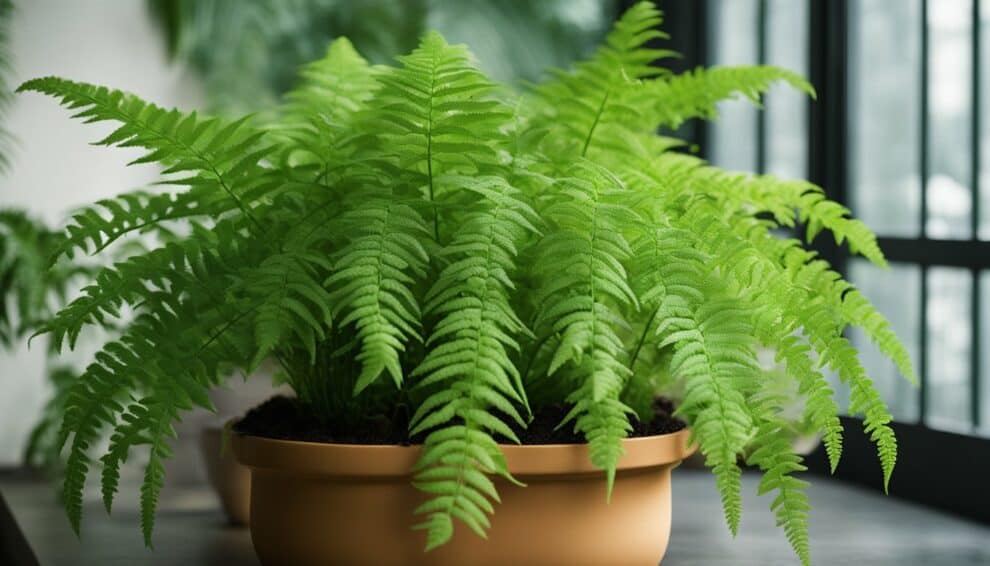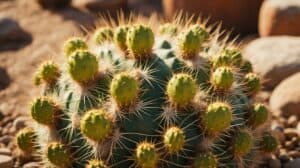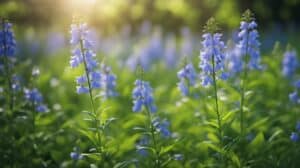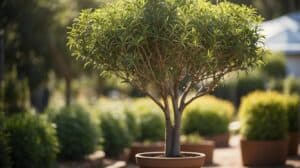Davallia fejeensis, commonly known as the Rabbit’s Foot Fern, is a popular houseplant that is native to Fiji.
This fern gets its name from the furry rhizomes that grow above the soil and resemble a rabbit’s foot.
The fern’s delicate, lacy fronds add a touch of elegance to any room and are relatively easy to care for.

If you’re looking to add a Rabbit’s Foot Fern to your collection, it’s important to know how to properly care for it.
This fern prefers bright, indirect light and well-draining soil.
Overwatering can lead to root rot, so it’s important to allow the soil to dry out slightly between waterings.
With the right care, your Rabbit’s Foot Fern can thrive and bring a touch of nature into your home.
Understanding Davallia Fejeensis
Species Overview
Davallia fejeensis, commonly known as the Rabbit’s Foot Fern, is a popular houseplant that belongs to the family Davalliaceae.
It is a tropical fern that is native to Fiji, where it grows as an epiphyte on trees or rocks.
The plant has a unique appearance, with furry rhizomes that resemble a rabbit’s foot and delicate fronds that grow in a circular pattern.
Common Names
Apart from Rabbit’s Foot Fern, Davallia fejeensis is also known by other common names such as Hare’s Foot Fern, Squirrel’s Foot Fern, and Deer’s Foot Fern.
These names are derived from the plant’s rhizomes, which have a furry texture and resemble the feet of different animals.
Origin and Habitat
As mentioned earlier, Davallia fejeensis is native to Fiji, where it grows in tropical rainforests and on rocky outcrops.
The plant prefers a warm and humid environment and can be found growing on trees, rocks, or on the forest floor.
It is an epiphytic fern, which means that it grows on other plants without harming them.
In cultivation, the Rabbit’s Foot Fern is grown in pots or hanging baskets and is often used as a decorative indoor plant.
Overall, Davallia fejeensis is a unique and attractive plant that is relatively easy to grow and care for.
Its furry rhizomes and delicate fronds make it a popular choice among houseplant enthusiasts.
Cultivation Guide

Light Requirements
Davallia Fejeensis, commonly known as the Rabbit’s Foot Fern, thrives in bright but indirect light.
Direct sunlight can damage the leaves, so it’s best to place the plant in a spot that receives filtered light for a few hours each day.
A north or east-facing window is ideal, but if that’s not possible, you can use sheer curtains or blinds to filter the light.
Watering Schedule
The Rabbit’s Foot Fern prefers to be kept consistently moist but not waterlogged. Water the plant when the top inch of soil feels dry to the touch.
It’s important to use room temperature water and avoid letting the plant sit in standing water, as this can lead to root rot.
In the winter months, when the plant is not actively growing, reduce watering frequency.
Soil Composition
The Rabbit’s Foot Fern prefers well-draining soil that’s rich in organic matter.
A mixture of peat moss, perlite, and sand or vermiculite can create a suitable growing medium.
It’s important to repot the plant every 1-2 years to prevent it from becoming root-bound.
Temperature and Humidity
The Rabbit’s Foot Fern thrives in warm, humid environments.
Ideal temperatures range from 60-75°F (15-24°C), and humidity levels should be around 50-60%.
You can increase humidity by placing a tray of water near the plant or using a humidifier.
Avoid placing the plant near drafts or heating vents, as this can cause the leaves to dry out.
Propagation Methods

Davallia fejeensis, commonly known as Rabbit’s Foot Fern, is a popular houseplant that can be propagated in two ways: division and spore propagation.
Division
Division is the most common method of propagating Rabbit’s Foot Fern.
It involves separating the plant into smaller sections, each with its own root system.
This can be done when the plant has outgrown its pot or when the fronds have become too long.
To divide the plant, carefully remove it from its pot and gently separate the root ball into smaller sections.
Each section should have at least two fronds and a healthy root system. Re-pot each section into a new pot with fresh potting soil and water thoroughly.
Spore Propagation
Spore propagation is a more challenging method of propagating Rabbit’s Foot Fern.
It involves collecting spores from the underside of mature fronds and growing them into new plants.
To collect spores, select a mature frond and place a piece of paper underneath it. Gently shake the frond to release the spores onto the paper.
Sprinkle the spores onto a tray of moist peat moss and cover with plastic wrap. Keep the tray in a warm, humid location and mist it regularly.
After a few weeks, the spores will begin to germinate and grow into small ferns.
Once they have grown large enough, transplant them into individual pots with fresh potting soil and water thoroughly.
By following these propagation methods, you can easily grow new Rabbit’s Foot Ferns and expand your collection.
Care and Maintenance

Fertilizing
Davallia fejeensis, also known as the Rabbit’s Foot Fern, requires regular fertilization to ensure healthy growth.
During the growing season, which is typically from spring to early fall, it is recommended to fertilize the plant every two weeks.
A balanced, water-soluble fertilizer with equal parts of nitrogen, phosphorus, and potassium is ideal.
Pruning
Pruning is an essential part of maintaining the appearance and health of the Rabbit’s Foot Fern.
It is recommended to remove any yellow or brown fronds as they can indicate disease or pest problems.
Additionally, pruning can help to control the size and shape of the plant.
To prune, use sharp, clean scissors or pruning shears to cut the frond as close to the base as possible without damaging the surrounding foliage.
Repotting
Davallia fejeensis should be repotted every two to three years to ensure healthy growth.
It is best to repot in the spring when the plant is actively growing.
Choose a pot that is one size larger than the current one and fill it with a well-draining potting mix.
Carefully remove the plant from its current pot and gently loosen the roots.
Place the plant in the new pot and fill with soil, making sure to leave enough room for watering.
Pest and Disease Management
Like all plants, the Rabbit’s Foot Fern is susceptible to pests and diseases. Common pests include spider mites, mealybugs, and scale insects.
If you notice any signs of infestation, such as yellowing or curling leaves, use a gentle insecticidal soap to control the problem.
Additionally, the plant can be prone to fungal diseases, such as root rot, if overwatered.
To prevent this, make sure to allow the soil to dry out slightly between waterings and avoid getting water on the foliage.
Frequently Asked Questions

What type of soil is ideal for growing a Rabbit’s Foot Fern?
Davallia fejeensis, commonly known as the Rabbit’s Foot Fern, thrives in well-draining soil that is rich in organic matter.
A soil mix that is equal parts peat moss, perlite, and coarse sand is ideal for these ferns.
It is important to ensure that the soil is moist but not waterlogged, as these ferns are sensitive to overwatering.
How often should I water my Rabbit’s Foot Fern?
Rabbit’s Foot Ferns require consistent moisture, but they should not be overwatered.
It is recommended to water these ferns once a week, or when the top inch of soil feels dry to the touch.
It is important to avoid letting the soil dry out completely, as this can cause the fern’s fronds to wilt and die.
What are the common issues to look out for when caring for a Rabbit’s Foot Fern?
One of the most common issues when caring for a Rabbit’s Foot Fern is overwatering.
These ferns are sensitive to waterlogged soil, which can cause root rot and other fungal diseases.
Additionally, these ferns may be susceptible to spider mites and mealybugs, which can be controlled through regular inspection and treatment with insecticidal soap.
Can Rabbit’s Foot Ferns be grown in pots, and if so, how?
Rabbit’s Foot Ferns can be grown in pots, but it is important to choose a container that is large enough to accommodate the fern’s root system.
It is recommended to use a pot that is one size larger than the current container, and to ensure that the pot has drainage holes to prevent waterlogging.
It is also important to use a well-draining soil mix and to water the ferns regularly.
What are the steps for propagating a Rabbit’s Foot Fern effectively?
Rabbit’s Foot Ferns can be propagated through division, which involves separating the fern’s rhizomes into smaller sections and replanting them in new containers.
To do this, gently remove the fern from its pot and carefully separate the rhizomes using a sharp knife.
Replant the sections in fresh soil and water them well.
Are there any particular benefits to having a Rabbit’s Foot Fern at home?
In addition to their aesthetic appeal, Rabbit’s Foot Ferns are known for their air-purifying properties.
These ferns can help to remove toxins from the air, making them a great addition to any home or office space.
Additionally, these ferns are relatively low-maintenance and can thrive in a variety of indoor environments.














